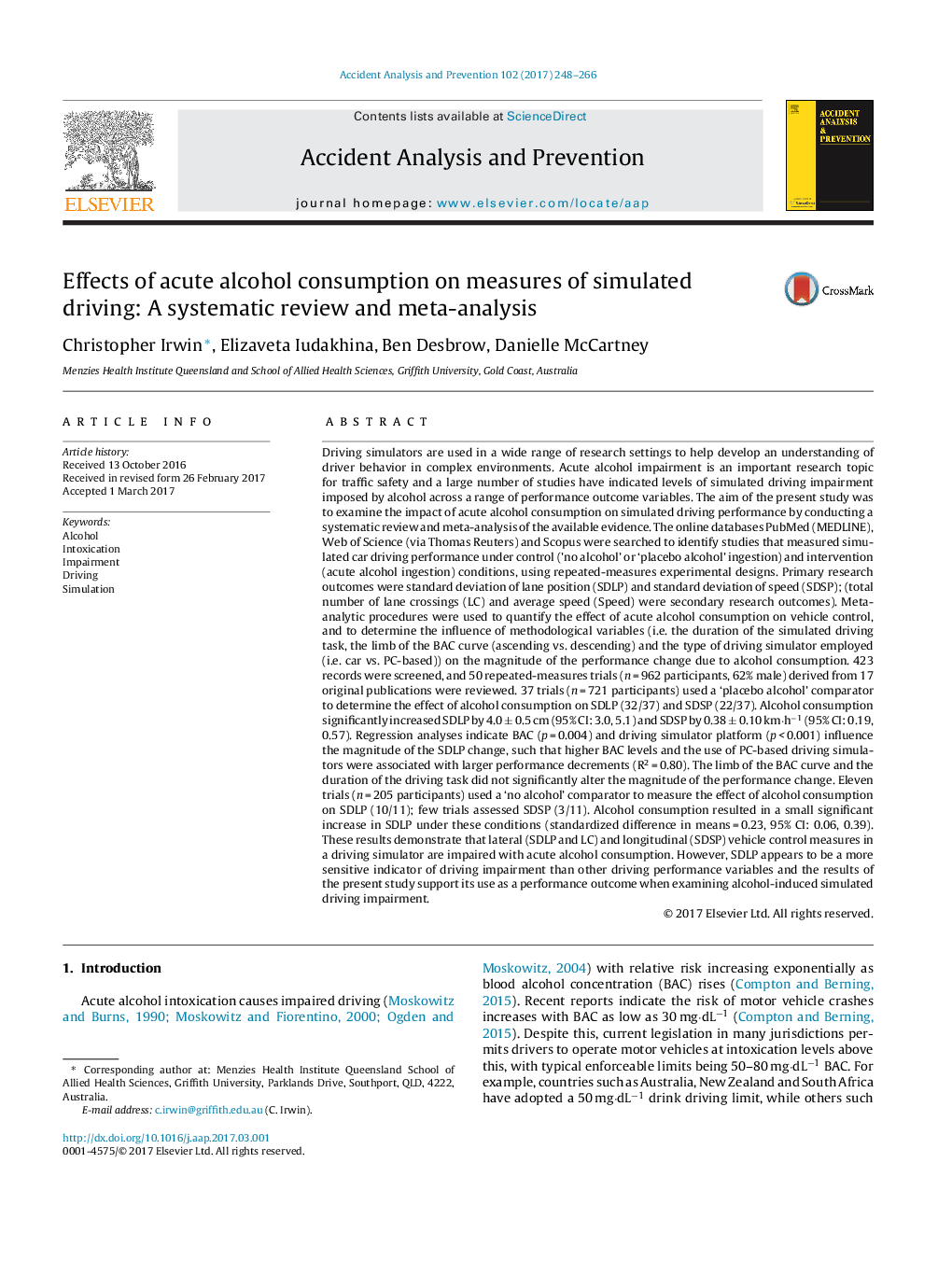| کد مقاله | کد نشریه | سال انتشار | مقاله انگلیسی | نسخه تمام متن |
|---|---|---|---|---|
| 4978610 | 1452897 | 2017 | 19 صفحه PDF | دانلود رایگان |
عنوان انگلیسی مقاله ISI
Effects of acute alcohol consumption on measures of simulated driving: A systematic review and meta-analysis
ترجمه فارسی عنوان
اثرات مصرف الکل حاد بر اندازه گیری رانندگی شبیه سازی شده: یک بررسی سیستماتیک و متا آنالیز
دانلود مقاله + سفارش ترجمه
دانلود مقاله ISI انگلیسی
رایگان برای ایرانیان
کلمات کلیدی
الکل، مسمومیت نقص رانندگی، شبیه سازی،
موضوعات مرتبط
مهندسی و علوم پایه
مهندسی شیمی
بهداشت و امنیت شیمی
چکیده انگلیسی
Driving simulators are used in a wide range of research settings to help develop an understanding of driver behavior in complex environments. Acute alcohol impairment is an important research topic for traffic safety and a large number of studies have indicated levels of simulated driving impairment imposed by alcohol across a range of performance outcome variables. The aim of the present study was to examine the impact of acute alcohol consumption on simulated driving performance by conducting a systematic review and meta-analysis of the available evidence. The online databases PubMed (MEDLINE), Web of Science (via Thomas Reuters) and Scopus were searched to identify studies that measured simulated car driving performance under control ('no alcohol' or 'placebo alcohol' ingestion) and intervention (acute alcohol ingestion) conditions, using repeated-measures experimental designs. Primary research outcomes were standard deviation of lane position (SDLP) and standard deviation of speed (SDSP); (total number of lane crossings (LC) and average speed (Speed) were secondary research outcomes). Meta-analytic procedures were used to quantify the effect of acute alcohol consumption on vehicle control, and to determine the influence of methodological variables (i.e. the duration of the simulated driving task, the limb of the BAC curve (ascending vs. descending) and the type of driving simulator employed (i.e. car vs. PC-based)) on the magnitude of the performance change due to alcohol consumption. 423 records were screened, and 50 repeated-measures trials (n = 962 participants, 62% male) derived from 17 original publications were reviewed. 37 trials (n = 721 participants) used a 'placebo alcohol' comparator to determine the effect of alcohol consumption on SDLP (32/37) and SDSP (22/37). Alcohol consumption significantly increased SDLP by 4.0 ± 0.5 cm (95% CI: 3.0, 5.1) and SDSP by 0.38 ± 0.10 kmâ
hâ1 (95% CI: 0.19, 0.57). Regression analyses indicate BAC (p = 0.004) and driving simulator platform (p < 0.001) influence the magnitude of the SDLP change, such that higher BAC levels and the use of PC-based driving simulators were associated with larger performance decrements (R2 = 0.80). The limb of the BAC curve and the duration of the driving task did not significantly alter the magnitude of the performance change. Eleven trials (n = 205 participants) used a 'no alcohol' comparator to measure the effect of alcohol consumption on SDLP (10/11); few trials assessed SDSP (3/11). Alcohol consumption resulted in a small significant increase in SDLP under these conditions (standardized difference in means = 0.23, 95% CI: 0.06, 0.39). These results demonstrate that lateral (SDLP and LC) and longitudinal (SDSP) vehicle control measures in a driving simulator are impaired with acute alcohol consumption. However, SDLP appears to be a more sensitive indicator of driving impairment than other driving performance variables and the results of the present study support its use as a performance outcome when examining alcohol-induced simulated driving impairment.
ناشر
Database: Elsevier - ScienceDirect (ساینس دایرکت)
Journal: Accident Analysis & Prevention - Volume 102, May 2017, Pages 248-266
Journal: Accident Analysis & Prevention - Volume 102, May 2017, Pages 248-266
نویسندگان
Christopher Irwin, Elizaveta Iudakhina, Ben Desbrow, Danielle McCartney,
